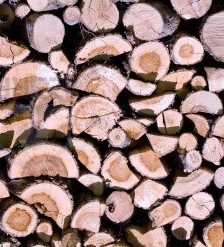If you are serious about wood fired heating you are going to have to think about storage.
How Long Do You Need To Store?
Firewood should be seasoned, until it is thoroughly dried out.
For freshly cut wood that typically means for at least 2 years.
Wood gathered from the forest floor still needs at least a years storage.
Unseasoned wood doesn’t burn as efficiently as seasoned wood. The difference is noticeable, and some of the problems are:
- The volatile components won’t ignite such as creosote.
- The volatiles are deposited as a black mess (which is highly flammable once it dries) on the inside of the flue.
- There will be too much smoke.
- There will lot of steam going up the flue, Which carries a lot of the heat with it.
Storage Locations
As Enough Wood for a Year is around 10 cubic m you need to be able to store around twice that amount.
This can be split between 3 places:
- An open storage for the first years storage. (The timber will still dry even though it is being rained on)
- A roofed storage for the second years storage. (Make sure this, and the first years storage is well away from the house)
- A day or two storage next to the door.(I just use a wheelbarrow)
What Not to Do
One of the things I sometimes see in those trendy magazines is firewood storage next to the fire. A bad idea in my opinion there is going to be a lot of spiders and other insects in the firewood.
See why Wood Heaters are Better than Open Fires
